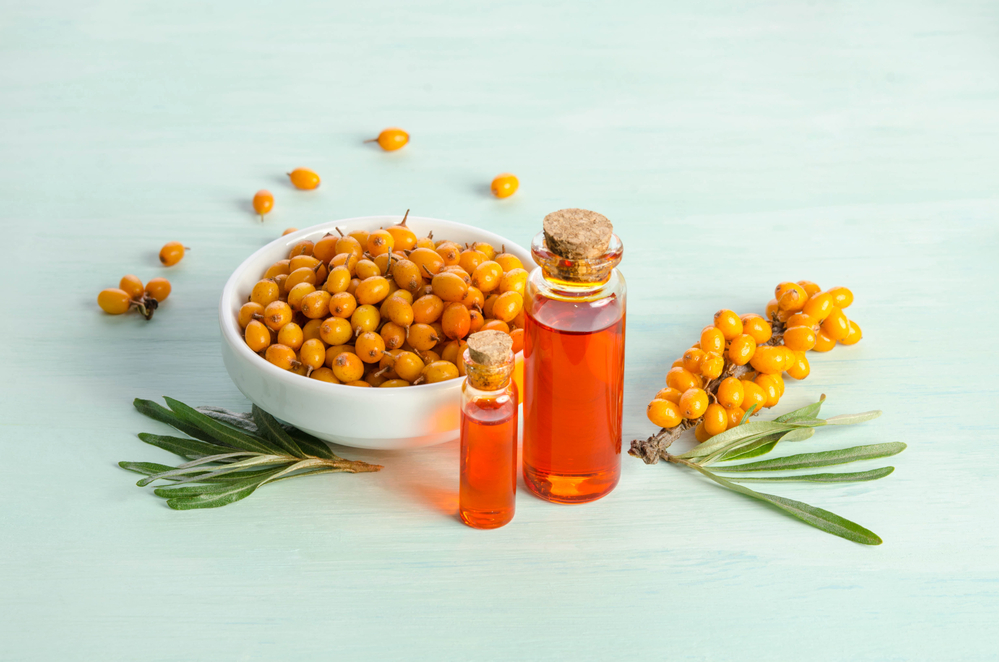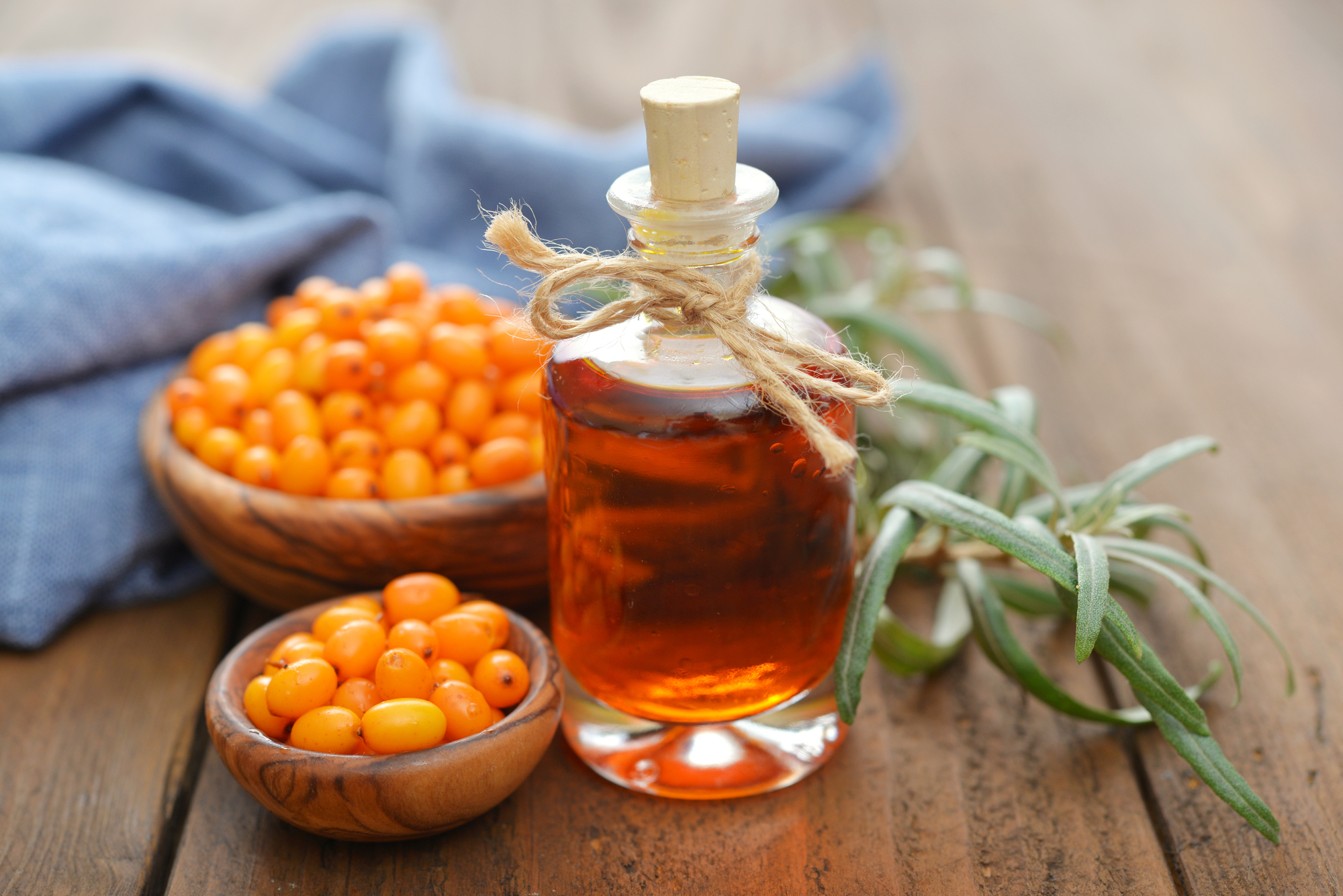Sea Buckthorn oil is a red-orange oil derived from either the fruit or the seed of the sea buckthorn plant. It is also known as sea buckthorn berry oil, sea buckthorn pulp oil, or sea buckthorn fruit oil when it is derived from the fruit. Otherwise, it is known as sea buckthorn seed oil when it is derived from the seeds. Sea buckthorn oil ingredient review focusing on the cosmetic benefits that this oil gives to formulations. It is a super-rich oil that is known for its anti-aging, nourishing, and barrier protecting properties. The cosmetic formulator should bear in mind that little goes a long way when added to skin care products – direct use or large concentrations can stain garments.
DIFFERENCE BETWEEN THE SEED OIL AND THE FRUIT OIL
The oils from the seed oil differ significantly from the fruit in their fatty acid content. The major fatty acid content of the seed oil is linoleic acid, while the fruit oil contains palmitoleic acid and palmitic acid. The color of the fruit oil is also dark orange while the seed oil is a pale yellow. It also contains mixed tocopherols, carotenoids, and plant sterols. The composition may also differ greatly from location to location or batch to batch. Approximates are contained below.
SEA BUCKTHORN INGREDIENT COMPOSITION
| COMPOUNDS | SEED OIL | FRUIT OIL |
| Fatty Acid Profile | Oleic acid (32.8%), Palmitic acid (26.3%), and Linoleic acid (21.7%) | Palmitoleic acid (30-48%), Palmitic acid (29.3 – 35%) |
| Vitamin E (Tocopherols and Tocotrienols) | 64-300mg/100g | 100-481mg/100g |
| Carotenoids+ (beta-carotene, zeaxanthin and lycopene) | 67.5-85 mg/100g | 350-2000 mg/100g |
| phytosterols (Mainly Beta-sitosterol) | 12-23g / 100g | 10-29g / 100g |
Figure 1.
Interested in cosmetic formulation? Sign up for our free course now
THERAPEUTIC ACTIVITY OF SEA BUCKTHORN OIL
Sea buckthorn oil is priced for its unique composition. In cosmetics, it is used extensively for its multiple benefits and applications to different skin types and conditions. Sea buckthorn oil is able to penetrate the epidermis to give detoxifying effects, stimulate blood circulation, and facilitate oxygenation of the skin. Its free tocopherol content acts as an antioxidant, helping to protect cell membranes from oxidative effects of free radicals. It is especially effective against sun-induced oxidative stress. The gamma-linolenic acid content in seabuckthorn is converted to prostaglandins within the skin, therefore it is better able to protect the skin against infections, prevent allergies, soothe and remove inflammation.

Sea buckthorn’s anti-inflammatory activities help treat inflammatory diseases like eczema and acne, It protects the epithelium and plays a role in the regenerating process of the skin. The high content of palmitic and palmitoleic helps support the skin barrier function. This is especially important for skin conditions such as acne, and eczema. Its high palmitoleic content is responsible for delaying the signs of aging, such as wrinkles and premature cell death.
Sea Buckthorn oil also contains Pro-vitamin A in the form of beta-carotene. Beta carotene is changed to vitamin A within the skin. This vitamin is also what gives this oil its dark-orange/red-orange color. Vitamin A is useful in the treatment of aging skin and acne.
BENEFITS
- Moisturizing; used to treat dry and flaky skin
- Used to delay the signs of again
- Skin brightening effects
- Helps prevents allergies
- Anti-inflammatory activity
- Skin rejuvenating formulations (it can be especially beneficial in rapidly aging skin)
- Skin repair and wound healing support
- It can detoxify the skin of toxins
- Easily absorption into the epidermis
- Skin firming
- Strong protection against environmental stressors
- Improves blood circulation
- Promotes cell longevity through oxygenation
SEA BUCKTHORN OIL INGREDIENT REVIEW FOR SKINCARE APPLICATIONS
Anti-Aging, Anti-Acne, Skin Rejuvenating, Restoring, Soothing, Brightening
CONLCUSION
Sea buckthorn oil is a multi-purpose, skin nourishing, rejuvenating and protecting oil that is of particular benefit to mature skin types and acne-prone skin. It’s nourishing and anti-inflammatory properties make it ideal for supporting the skin against environmental stressors, pathogens, and premature aging.
Learn How to Start a Cosmetic Business
REFERENCES
Kallio H, Yang B, Peippo P, Tahvonen R, Pan R (April 2002). “Triacylglycerols, glycerophospholipids, tocopherols, and tocotrienols in berries and seeds of two subspecies (ssp. sinensis and mongolica) of sea buckthorn (Hippophaë rhamnoides)”. Journal of Agricultural and Food Chemistry. 50 (10): 3004–3009
Andersson SC, Olsson ME, Johansson E, Rumpunen K (January 2009). “Carotenoids in sea buckthorn ( Hippophae rhamnoides L.) berries during ripening and use of pheophytin a as a maturity marker”. Journal of Agricultural and Food Chemistry
Biochemical Systematics and Ecology. Volume 32, Issue 9, September 2004, Pages 809-816

